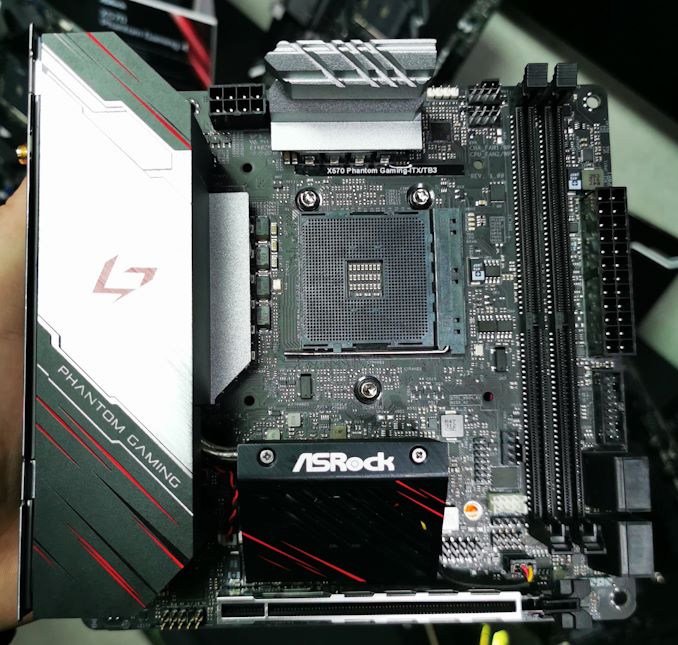The AMD X570 Motherboard Overview: Over 35+ Motherboards Analyzed
by Gavin Bonshor on July 9, 2019 8:00 AM ESTASRock X570 Phantom Gaming-ITX TB3
Well-known in recent times for its impressive mini-ITX motherboard, the ASRock X570 Phantom Gaming-ITX TB3 includes a very solid feature set. The ASRock X570 Phantom Gaming-ITX TB3 joins a small handful of small form factor X570 models at launch but looks to stand-out from the crowd with a major feature; a Thunderbolt 3 Type-C connector on the rear panel.

Following in line with the rest of its premium X570 product stack, ASRock has equipped the board with a hefty looking 10-phase power delivery, and official support for DDR4-4533 memory across two available slots with a total capacity of up to 64 GB. A single full-length PCIe 4.0 x16 slot is located at the bottom of the board, with a single PCIe 4.0 x4 M.2 slot, and just four SATA ports. The networking is handled by an Intel Gigabit LAN port, while the Wi-Fi 6 802.11ax wireless interface is controlled by the Killer AX1650 interface with support for BT 5 devices.

On the rear panel alongside the single Thunderbolt 3 Type-C connector which is the highlight of the board, the ASRock X570 Phantom Gaming-ITX TB3 also includes two USB 3.1 G2 Type-A and two USB 3.1 G1 Type-A ports. This is contradictive on the official specifications that were given to us at Computex which stated this model has two USB 3.1 G2 Type-A ports on the rear, as well as two USB 2.0 ports which also seem to be missing from the rear panel. On the display model at Computex, there is a clear CMOS button, a DisplayPort input and HDMI video output, with a PS/2 combo port, and five 3.5 mm color coded audio jacks with a S/PDIF optical output due to the use of a Realtek ALC1220 HD audio codec.
The ASRock X570 Phantom Gaming-ITX TB3 mini-ITX motherboard looks to stand out from other brands mini-ITX offerings with the Thunderbolt 3 which has been a mainstay of its desktop-focused small form factor models of recent times. A solid looking 10-phase power delivery similar to that of the ASRock Z390 Phantom Gaming-ITX/ac model we reviewed makes this even more appealing to users looking to push out the overclocks on the new Ryzen 3000 series processors. The X570 Phantom Gaming-ITX TB3 has an MSRP of $300, which is by no means cheap in comparison to its other mini-ITX models of late.










225 Comments
View All Comments
DigitalFreak - Tuesday, July 9, 2019 - link
I think the only advantage of using a 2000 series CPU with an X570 board will be PCIe 3.0/4.0 support. The X370/X470 only supported PCIe 2.0. In theory, the connection from the 2000 processor to the X570 chipset should run at PCIe 3.0 speeds.FreckledTrout - Tuesday, July 9, 2019 - link
The x370 chipset and x470 both supported PCIe 3.0 with either a 1xxx or 2xxx Ryzen CPU. If you are not running a 3xxx CPU in the x570 board there isn't any major feature that should cause one to want to upgrade.DigitalFreak - Tuesday, July 9, 2019 - link
@FreckledTrout - Yes and no. The interconnect between the CPU and the chipset is PCIe 3.0 on X370 / X470, but all the PCIe lanes that come off the chipset are 2.0. Running a 2000 series CPU in an X570 board would give you a PCIe 3.0 link between the CPU and the chipset, with either PCIe 3.0 or 4.0 lanes coming off the chipset (depends on if AMD drops everything to PCIe 3.0 with a 2000 series processor).extide - Tuesday, July 9, 2019 - link
It looks like they still allow the chipset lanes to be 4.0. So you'd have 3.0 link to cpu, but 4.0 from chipset to devices.Targon - Thursday, July 11, 2019 - link
Since you have at least one or two PCI Express slots that are connected to the CPU, not chipset, that almost becomes a non-issue. On my Asus ROG Crosshair VI Hero(X370), you have PCI Express 3.0 x16 for the first slot, or x8/x8. The third PCI Express x16 slot is a 2.0 I believe, which is still enough to get the job done for many devices. Even with the X570 board with a first or second generation Ryzen processor, the most you end up with is an extra 3.0 supporting slot. Note that many boards may have x16 slots, but they are x8 electrically, so you won't see the full bandwidth anyway in those slots.sorten - Tuesday, July 9, 2019 - link
Thanks Gavin! This is a great resource and is exactly what I needed to help build my new system.willis936 - Tuesday, July 9, 2019 - link
The return of the 40mm fan! Those are the most obnoxious components ever. No one has missed them in the past ten years.Kastriot - Tuesday, July 9, 2019 - link
Buy Asrock aqua and problem solved.FreckledTrout - Tuesday, July 9, 2019 - link
I'm waiting for the next iteration of board for this reason. I'm speculating the next round the chipset will be on 7nm.abufrejoval - Tuesday, July 9, 2019 - link
The genious about that chiplet design is that the chipset doesn't actually benefit nearly as much from the shrink, as pure logic or SLC caches: The monolithic guys pay the 7nm overhead (e.g. EUV) for I/O while the geometry of the transistors in the I/O area is mostly determined by the need to power long motherbord or even slot traces.So while waiting is never a bad idea when your need clearly isn't overwhelming you, waiting for that shrink could turn out rather long. These days I/O heave chips might never be done in smaller geometries, because of that and because packaging has matured.